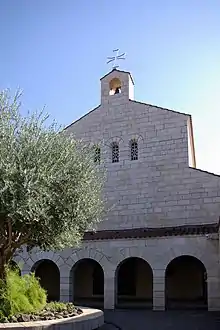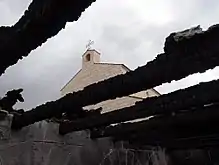Church of the Multiplication
The Church of the Multiplication of the Loaves and Fish, shortened to the Church of the Multiplication, is a Roman Catholic church located at Tabgha, on the northwest shore of the Sea of Galilee in Israel. The modern church rests on the site of two earlier churches.
| Church of the Multiplication | |
|---|---|
 Exterior of the church | |
| Religion | |
| Affiliation | Roman Catholic |
| Leadership | Benedictines |
| Year consecrated | 1982 |
| Location | |
| Location | |
| Architecture | |
| Completed | 1982 |
Religious affiliation
The church is maintained and overseen by the Benedictine Order.
History
First Byzantine church (4th century)
The first church, built alongside the important road that passes by, was erected around AD 350.
Second Byzantine church (5th century)
The church was significantly enlarged around the year 480, with floor mosaics also added at this time. These renovations are attributed to the Patriarch Martyrius of Jerusalem. In AD 614 Persians destroyed the Byzantine church.[1]
19th-20th-century rediscovery
After the AD 614 destruction, the exact site of the shrine was lost for some 1,300 years. In 1888 the site was acquired by the German Catholic Society for Palestine (Palästina-Verein der Katholiken Deutschlands) which was associated with the Archdiocese of Cologne. An initial archaeological survey was conducted in 1892, with full excavations beginning in 1932. These excavations resulted in the discovery of mosaic floors from the 5th-century church, which was also found to be built on the foundations of a much smaller 4th-century chapel.
20th-century reconstruction
Since 1939 the property has been administered by the Benedictine order as a daughter-house of the Dormition Abbey in Jerusalem. The ground was bought in 1888 by the German Catholic Palestine Mission, archeological research started in 1892. In the 1930s a provisional protective structure was erected above the holy rock and the Byzantine mosaics. The current church, inaugurated in 1984, was built to the same floor plan as the 5th-century Byzantine church, some of the ancient black basalt walls have survived and remain visible. The Cologne-based architects Anton Goergen and Fritz designed a simple, modest building in a somewhat neo-Byzantine style. The windows are fitted with alabaster panels. The bright limestone stones were brought from a quarry near Taybeh (between Jericho and Ramallah), the red bricks from Italy and the roof timbering from Germany.[2] The portal is a work by the German sculptor Elmar Hillebrand.[3][4]
Arson attack

On 17 June 2015, an auxiliary building next to the church was significantly damaged by an arson attack committed by Jewish extremists.[5] Hebrew graffiti, with the words "false idols will be smashed", taken from the Jewish prayer Aleinu, was sprayed on the walls of the adjacent dormitory. This incident followed a series of arson and graffiti attacks by Jewish extremists against Christian sites. [6][7] Israeli officials have labeled the attack as "terrorism".[8] “Whatever repairs are not covered by insurance must be paid for by the Israeli government”, said Wadie Abunassar, media spokesman for the Assembly of Catholic Ordinaries of the Holy Land. “We believe this attack was tantamount to a terror attack, and when there is a terror attack the state is responsible for paying for compensation and prosecutes the perpetrators.”[9]
In late July 2015, four Israeli Jews age 18 to 24 and an unnamed minor were arrested by the Israel police and indicted for the arson. The suspects are reportedly associated with the Jewish extremist, ultra-nationalist "Hilltop Youth".[10][11][12][13]
The media coverage at the time of the arson largely distorted the fact that the church building itself had been unharmed. In February 2017, new media reports suggested that the church itself had been closed for nearly two years as a result for the arson attack, although it was open throughout the time.[14] [15]
Interior
Layout
The interior of the church has a central nave and two aisles. The sanctuary is backed by an apse with transepts on either side. Under the altar is a block of limestone found during excavation, that is venerated as the stone on which the miraculous meal was laid.
Mosaics
One of the main highlights of the church are its restored 5th-century mosaics. These are the earliest known examples of figurative floor mosaics in Christian art in the Holy Land. The mosaics in the two transepts depict various wetland birds and plants, with a prominent place given to the lotus flower. This flower, which is not indigenous to the area, suggests the artist's use of a Nilotic landscape popular in Roman and Early Byzantine art. All the other motifs depict plants and animals from the Galilee. The mosaic found in front of the altar depicts two fish flanking a basket containing four loaves of bread.
Outside the atrium
A basalt-made oil press is displayed in the courtyard, as is a baptismal font outside of it.
Gallery
 Exterior of the church
Exterior of the church Interior of the church
Interior of the church Mosaic in the church
Mosaic in the church
References
- "The Church of the Multiplication of Loaves and Fishes | Dormitio-Abtei". Dormitio-Abtei (in German). Retrieved 12 August 2017.
- Markus Krastl: Tabgha als Memorialstätte der Speisung der Fünftausend. Trier 2002, S. 32.
- Margarete Preuss: Das Kirchenportal als Eingangstür zur Begegnung mit Gott; Die Brotvermehrungskirche in Tabgha erhielt Bronzeportale. In: Das heilige Land 118 (1986), S. 19 f.
- Christoph Wolters: Das Bronzeportal der Brotvermehrungskirche in Tabgha (Israel). In: Das Münster 40 (1987), S. 109–112.
- Two Men Indicted for Church of the Loaves and Fishes Arson Attack. Available at: http://www.haaretz.com/israel-news/.premium-1.668589
- Noa Shpigel and Barak Ravid (18 June 2015). "Arson Suspected at Church of Loaves and Fish in Northern Israel". Haaretz. Retrieved 30 November 2016.CS1 maint: uses authors parameter (link)
- Ben Lynfield (18 June 2015). "Jewish extremists suspected of torching Sea of Galilee 'loaves and fishes' church in Tabgha". The Independent. Retrieved 19 June 2015.
- Sea of Galilee church where 'Jesus fed 5,000,' torched in suspected hate attack | The Times of Israel. 2015. Sea of Galilee church where 'Jesus fed 5,000,' torched in suspected hate attack | The Times of Israel. [ONLINE] Available at: http://www.timesofisrael.com/arson-suspected-in-fire-at-church-on-sea-of-galilee/.
- The Jewish Week, 20 July 2015
- Hartman, Ben (29 July 2015). "Suspects from extremist Jewish group indicted for arson of Church of Loaves and Fishes". Jerusalem Post. Retrieved 4 September 2015.
- Levinson, Chaim; Shpigel, Noa (30 July 2015). "DNA and Cameras: Police Reveal How They Solved Church of Fish and Loaves Arson". Haaretz. Retrieved 4 September 2015.
- Shpigel, Noa (14 August 2015). "Arson Suspect in Galilee Church Torching Charged With Sedition". Haaretz. Retrieved 4 September 2015.
- "Supreme Court Rejects Church Arson Suspect's Appeal". Arutz Sheva. 4 September 2015. Retrieved 4 September 2015.
- Sinclair, Kenya (13 February 2017). "Church of the Multiplication of the Loaves and Fishes survives Jewish extremist attack - Celebrates first Mass in 2 years - Middle East - International - News - Catholic Online". Catholic Online. Retrieved 12 August 2017.
- "Famed church in Israel reopens 2 years after arson attack". AP News. Retrieved 12 August 2017.
External links
| Wikimedia Commons has media related to Church of the Multiplication. |
- Church of the Multiplication Israel Ministry of Foreign Affairs
- Church of the Loaves and Fish, Tabgha